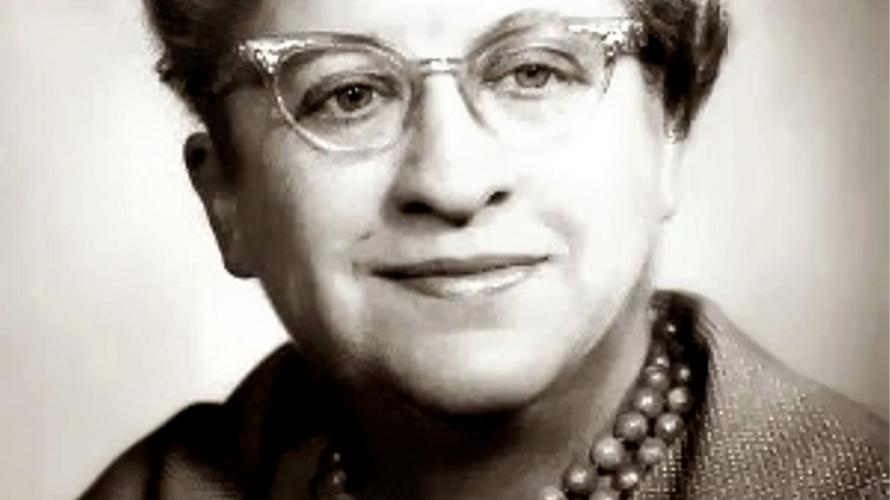
Dorothy M. Johnson, a witty, gritty Western taleteller famous for such books as “The Man Who Shot Liberty Valance,” died Sunday, November 11, 1984, at her home in Missoula’s West Rattlesnake Valley.
She was 78 and had suffered from Parkinson’s disease and other illnesses for the final couple of years of her life. Before her death, the author of “The Hanging Tree,” “The Bloody Bozeman,” “A Man Called Horse,” and many other books, short stories and magazine articles specified that the inscription on her grave marker be “PAID.”
“God and I know what it means,” she said in an interview shortly before her death, “and nobody else needs to know.”
Born Dec. 19, 1905, in McGregor, Iowa, to Lester E. and Louisa Barlow Johnson, Dorothy Marie Johnson moved to Great Falls, in 1909, and later Whitefish, in 1913. Johnson described her childhood in Whitefish in several lengthy magazine articles.
“The raw new town where I grew up – Whitefish, Montana – swarmed with money-hungry children who were willing to do almost anything to make an honest nickel. The trouble was that just about everything you could do was part of your normal chores and you didn’t get paid for it. Like filling the woodbox or lugging in a bucket of water while your mother admonished automatically, “Now don’t hurt your back,” or splitting kindling while she warned, “Now don’t chop your foot.”Or feeding the chickens, carrying out the slop bucket, washing dishes, picking potato bugs and shoveling snow…After I explained gladly about allowances (it was seldom that I knew more about something than my parents did), they got the idea across tactfully that maybe some children in some places received allowances but no such outlandish custom was going to be introduced in Whitefish, anyway not at our house. That was back in the days when parents and children could still communicate with no trouble.”
Johnson published several articles about her childhood in Montana The Magazine of Western History. Her nonfiction conveys her love of Montana and her interpretation of the West’s uniqueness. She described Whitefish as a “raw new town,” filled with opportunity credited to the jobs created by the Great Northern Railroad. For the workers attracted to Whitefish, it was “the anteroom of paradise . . . the promised land, flowing with milk and honey. All they had to do to enjoy it was work.”
In one of her writings, the diligent, reliable men and women of Whitefish stood out against the “rich people and Eastern dudes” she encountered in Glacier National Park. When she wrote of the social divide she noticed among visitors to the park, she viewed it in terms of an East-West split: “We unrich Westerners were suspicious of the whole lot of them. We looked down on them because we thought they looked down on us. But they didn’t even see us, which made the situation even more irritating. Years later, when I lived in a big Eastern city, I learned not to see strangers. . . . But in the uncrowded West, in my country, it’s bad manners, and on the trail it’s proper to acknowledge the existence of other human beings and say hello.”
Reared a widow’s daughter, she graduated from Whitefish High School in 1922 and studied premed at Montana State College in Bozeman before transferring to Montana State University in Missoula. By the time she graduated with a B A. degree in English in 1928, she had already published her first poem. She was married briefly with the last name of Peterkin.
After graduation, she found work as a stenographer in an Okanogan, Washington, department store. After another stenographer position in Menasha, Wisconsin, she spent fifteen years as a magazine editor in New York City at Gregg Publishing Company and Farrell Publishing Corporation.
From 1944-50 Johnson also edited a women’s magazine in New York City; she eventually returned to Whitefish where she became news editor of the Whitefish Pilot (1950-1953).
In 1953, she returned to the University of Montana as a member of the journalism faculty. She once told students, “One of the perils of going to the university is that you are liable to hear me tell you how to get on a horse three or four times before you graduate. Writers are like students—they sometimes have to learn things they don’t even want to know. Getting on a horse was part of the necessary information I had to learn. ”
Harold Guy (H. G.) Merriam, professor emeritus of English at the University of Montana and an American Rhodes scholar, and a major influence in Johnson’s early writing development, later said of her:
“She wrote prodigiously — story after story. I felt from the beginning that she had a real talent for them I think the reason for her success was that she kept right at it; she didn’t letup ...”
Johnson wrote sixteen books, beginning with “Beulah Bunny Tells All” in 1941 and ending with “All the Buffalo Returning” in 1979. Johnson’s most popular work, “The Man Who Shot Liberty Valence,” is simultaneously a period piece and an eternal tale of payback, love and honor redeemed that climaxes in a shootout. Johnson’s prose is graceful, and while her short stories might be standard, they’re also always transfixing and nuanced, with subtle forms of irony at each turn. Eventually turned into a western movie classic (1962) directed by John Ford, starring John Wayne and James Stewart, this is one of Johnson’s short stories that has endured.
In 1959, “The Hanging Tree” too became an unforgettable western movie. Gary Cooper, a fellow Montanan, starred in “The Hanging Tree,” and once gave Miss Johnson a pheasant wishbone which she copper plated and wore as a necklace.
Ultimately, Johnson was a complete and ideal Westerner, and this helped her do extremely well in a literary genre that tended to be dominated with male bylines. Johnson affirmed women’s ability to write Westerns: “After all, men who write about the Frontier West weren’t there either. We all get our historical background material from the same printed sources. An inclination to write about the frontier is not a sex-linked characteristic, like hair on the chest.”
Though Johnson never self-identified as a trailblazer or an activist, she was, according to one friend, a “witty, gritty little bobcat of a woman,” and her writings reflect her western strength of mind.
Following her death, a memorial service was held in Missoula on Wednesday, November 14, 1984. Her body was cremated and the ashes interred in Whitefish Cemetery next to the grave of her mother.
 Brian D’Ambrosio is the author of “Shot in Montana: A History of Big Sky Cinema.” Always on the search for vivid, interesting story ideas and subjects, he may be reached at [email protected]
Brian D’Ambrosio is the author of “Shot in Montana: A History of Big Sky Cinema.” Always on the search for vivid, interesting story ideas and subjects, he may be reached at [email protected]
